Understand Things as Interacting Systems
Understanding a complicated topic as interacting systems helps you learn its properties and gain agency. So what are systems?
A system is what is does.
Understand Things As Interacting Systems

Dr Katie Bouman interacting with a black hole, a team, and the world
TL;DR: jump to paragraph “Thinking in systems: why it helps” for why it matters, and then “Systems: tentative definition” (last paragraph) to have the short version :)
Lately, I discovered that most developers don’t conceptualize their applications as a set of interacting systems. I thought it was the “architecture 101” of application development, but after some more inquiring, I discovered that that view of the world was almost unknown, and not only among developpers. This came as a surprise to me because it is one of the most useful and powerful tools I have to systematically understand a topic, what its parts are, and what the contracts between them are. In the context of application development, it allows me to evolve large parts of the application letting other untouched. It allows to make communication easier with the team. It allows making actual contracts on the behaviour of your application with users, especially for long-term period. It allows evolving our internal understanding of the application domain without impacting third parties out of clear chosen changes.
This tool is so useful that I conceptualize most of my macro-interactions with the world as systems interacting together.
Seeing the world as systems is a useful tool
People believe systems are complicated{.markup–anchor .markup–p-anchor data-href=“https://en.wikipedia.org/wiki/Systems_theory" rel=“noopener” target="_blank”}. Perhaps linked to mechanics. Or physics. Or economy. Hard and boring stuff. They may be, but they don’t need to. I use ‘system’ loosely as a tool to better understand and contextualize a lot of topics.
Oh, notice how I introduced the subject? Systems are a useful learning model of the subject at hand. If they are not, change the model. Of course, useful is extremely subjective, so it means that your relation with the system is key to its definition. It’s OK if other groups of people come with other models, it can even help you to better communicate with them by understanding how they see the world.
So systems help me understand how thingies interact with each other.
Thinking in systems: why it helps (me, at least)
Concretely, thinking in interacting systems helps me to:
1/ understand what are the bounds between vague and composite things,
2/ give names that evoke the same group of things to other people that it does to me,
3/ understand what vocabulary and private references should be made explicit when communicating with other things,
4/ discover and understand communication channels,
5/ understand what is:
- [the nominal behaviour of interaction with the entity;]
- [what are the identified error cases and when I can expect them,]
- [and what is out of scope for that entity, and failures that lies in the uncharted lands.]
6/ know the implicit and explicit promises and the contracts that these entities give about their behaviour.
More importantly, thinking in systems helps to discover where our assumptions about the system of interest are false by sharing them and confronting them to other models and their real behavior, so that we can progress and refined our models to be less wrong. They will ever be, but the learning is the useful part, and in the process we gain agency on the world.
So it’s really a great learning and normalization tools. A developer dream, even if actually, it helps in many more situations. And I discovered that most of the developers I chat with don’t even know what a system is.
System examples
Systems can be more or less formalized, but a lot of formalization is not necessary to make them a useful learning tool. Let’s take some examples of systems to get a feeling about what they are.
Your band of friend at school
You went to school? That’s a nice set of interacting systems! A loosely defined one:
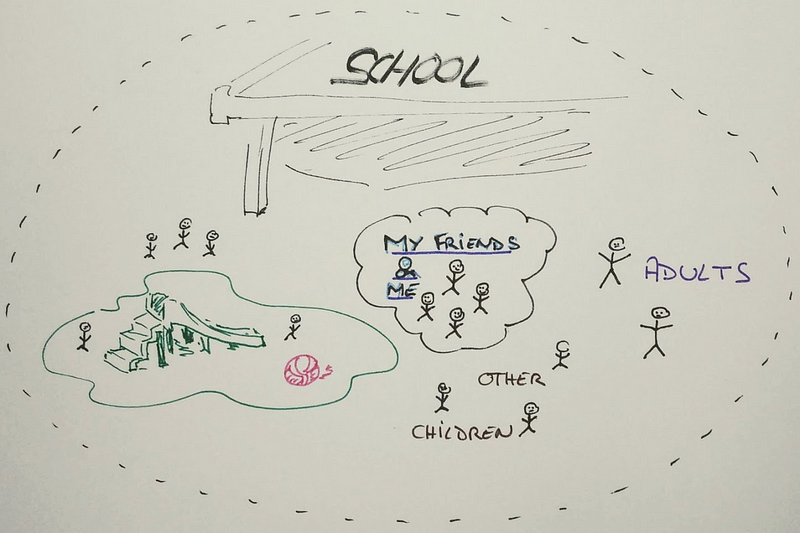
You and your friend formed a group (a system) in the school. There was Alice, Bob, Charlie and you. You were interacting with other macro-entities (other systems): other children, some of them belonging to other groups; parents and teachers (the boring adults). Sibling of friends. Etc.
Your group may even have been known by a nickname (hopefully something along Alice’s band more than the little terrors of the canteen).
You had your own private jokes and experiences which defined your internal language and the fact that adults got mad when you broke into laughs after a seemingly innocuous sentence.
Other people were getting in touch with each of you but Bob, because Bob was far too shy. Bob wasn’t an interface for chat, but a good one to get info about the last comic book. Most of the time, you were nice and you did as expected for 11-year-old children, apart from subjects regarding one given superhero. You were living encyclopedia about that one, especially Alice, and people expected long discussions and sharp corrections on that topic from her.
You were a system interacting with other humans. Understanding that helped other people interact efficiently with your group, using the correct channel to get things done, and understand your behaviour in school as a coherent entity.
A shop
Of course, any company is a system —and hopefully a system interacting with other ones. This time, we can even talk about a semi-formalized system. Look at that little tea shop:
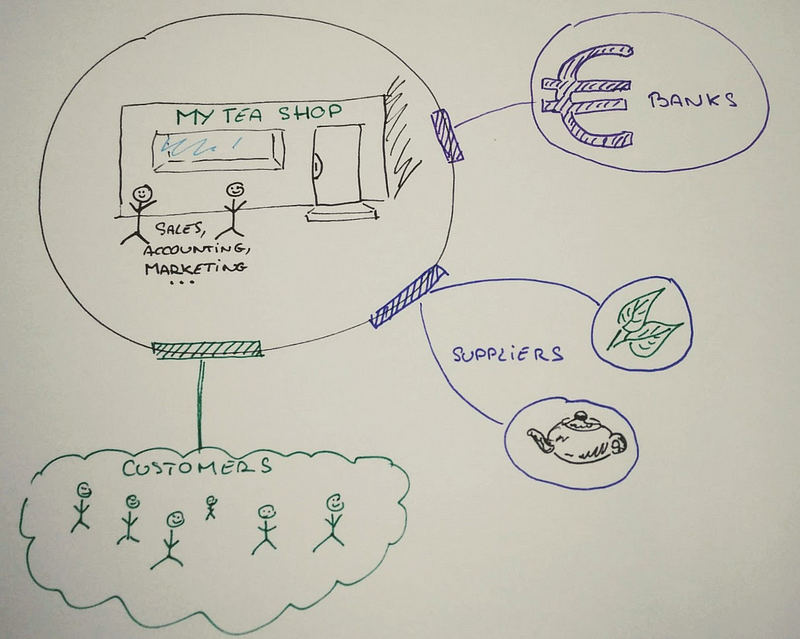
Wardley readers know how important tea shops are.
A shop is a legal entity with a lot of papers justifying so. It has a name. It is built to last (at least) for some time. In our tea shop case, and as it happens often, the two owners developed an internal language with expert vocabulary like “I put it behind the red teapot, you know which one” or “the Tuesday billing horror morning”. These sentences sumon perfectly unambiguous understanding of what they mean for each of the co-owners, even if for you, it’s totally opaque. They also know that after the conniving smile they exchanged, they will need to explain to you why they don’t like that much Tuesday mornings.
Of course, a shop is useless if it doesn’t interact with third parties like customers, banks and suppliers. There have several channels of exchange with the shop and they don’t expect the same kinds of interactions. Customers typically use the front door of the shop and are likely to buy some tea, when the bank uses your time and money (ok I’m kidding, the can use mail or fax for the most modern). Suppliers want to speak about the supply chain and invoices.
And of course, other systems see the shop through its promises: promise of experience projected by the brand and communication, promises of timely paid invoices in exchange for good products for suppliers, promises of positive accounts for the bank.
Again, understanding the shop interacting system can help us understand what each actor expects and how he can get it. It can help identify the tooling needed in each case, the different timelines. It helps gain agency and define reaction to identified use cases, so that they are better handled the next time.
Mathematical proof & code
Finally, system description can be extremely formalized, to the point where we are able to prove interesting properties about the world they model. HoTT{.markup–anchor .markup–p-anchor data-href=“https://homotopytypetheory.org/book/" rel=“noopener” target="_blank”} is such a system.
But even without going to that extreme, any code can be seen as interacting systems. Your application is composed of parts that deal with different kinds of users and different kinds of tasks. You want to know how what part talk to what others. What is the protocol and interface point to do so. You want to understand what will be the consequences of changing a line of code.
You want to name things to easily communicate what part of the application you are talking about to your teammates. You want to trace bounds to delimit responsibility and behaviour. You want to program to interfaces, and use protocols so that internal changes don’t leak to third party code. You want to know what is the nominal case AND the error modes to correctly react in each case.
So what are systems ?
In each of the previous example, we found common properties that make system useful tools. Let’s walk through each of them.
Systems are useful learning tools
We already saw that at the begining: building the model is what makes you understand it, question your assumptions, share your thoughts. Your models will be false — they are models! You learn with iterations, making them less false is possible.
Systems are entities…
A system is a model about entities, so you need at least things that last sufficiently long that you want to talk about them. It can be anything, from people to items to ideas and more.

Abstract entities
These things need to be in some sort of interaction, or at least relation. Again, here interaction and relation are very loosely defined, “the cars on the road” is totally fine, as much as “people who saw that series” or “these lines of codes”.
For example, the children from the previous school:
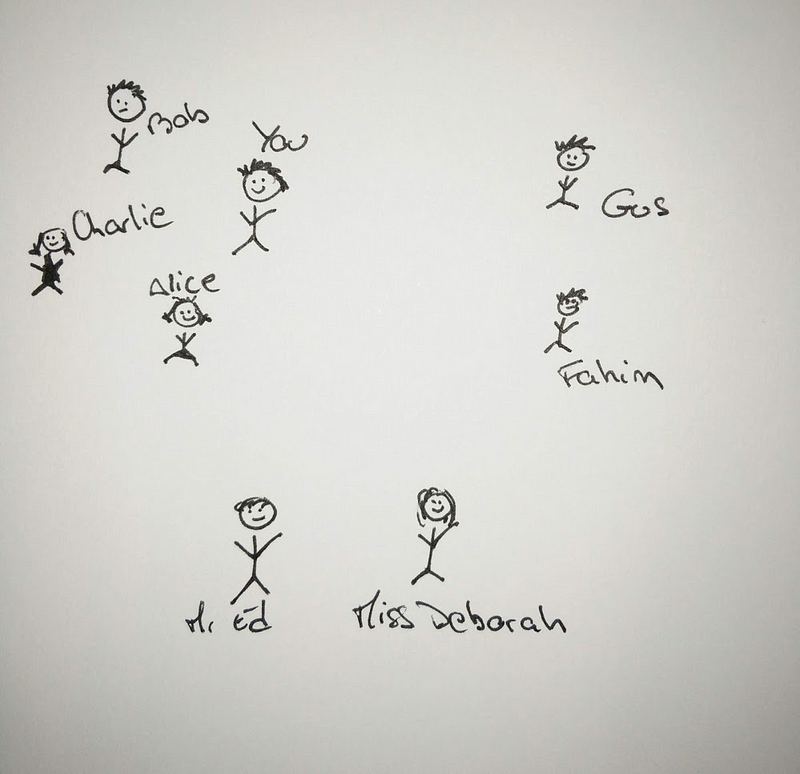
Sometime a little bit to concreate entities (if you are parents, you know)
So, you have things and links between them:

Abstractly interacting entities
This is your world, the thing you need to better understand, or just talk about with your friends.

Noisigly interacting entities
Defining systems — boundaries and names
And then, to transform that into interacting systems, you need to do (be careful, it will be very quick, don’t lose the track of my hands): draw lines around groups of things that belong together.
And tadaaaa, you have interacting systems — an ecosystem:

Tada! Colorful systems ! Choosing where to draw lines and why is the interesting part.
And give a name to each group. As you can see, you don’t even have to be good for the naming part, but at least you will be able to easily communicate to others (and yourself) what things you are talking about.
Again, “belong together” is up to you. It’s the part that makes the system definition helpful to reach your goal, to learn about the entities at hand. Thinking about the boundaries is what makes you understand your systems.
For example, if you want to build a long-lasting application, you could group code by the service it provides to other parts of the application. Or by how stable it must be because of third party integration. Or by sensitivity of managed data if you are on the security side of applications.
So each time you have interacting things, and you talk about a subpart of them, you are actually — even without knowing it — defining systems. Yep, you were doing it all that time.
Some examples of interacting systems:
“I love that book so much”.
System. With at least the people mostly sharing the ideas of narrators, and the ones who don’t.
“Did you correct the bug in that part of the application that looks if the user is connected?”.
System. And you should give a memrable name for that part of the application. And draw a big line around it, it seems important to be able to talk about its behaviour.
Or for the previous school example:

Creating systems is easy. Being ok with someone else (or you in 5min) about where to put the lines and what names should be used is the hard part
Internal language
As you defined a part “in” a system and a part “out” of it, you will see that the rules are not the same for things in and out.
A system develops an internal language. You know, your famous “business domain”, or even just your work expert vocabulary — the words that the outer world describes as “jargon” or “gibberish” most of the time. This internal language makes intra-system communications full of conventions, assumptions, non-obvious self-consistency. In exchange, your intra-system communications can be more precise and efficient.
Making explicit the boundaries of your system make it clear where you are allowed to use that internal language, and where you need to give more context, or even adapt to a common, less efficient but more broadly understood language.
Teachers talk to each other with pedagogical terms but they use common words to talk to parents. Alice’ Band has its private jokes and references which differ from Gus Band, but both agreed on a common, colorful language when they play together. And so on.
… interacting with other systems
These explicit boundaries also make apparent how all systems interact with each other.
Most of the time, you will be surprised by how much entangled systems are in reality, and how naive your circles were — that’s good ! You are learning about the topic at hand, and what you are starting to see are interfaces and communication protocols.
Interfaces
Interfaces are gates in the boundary of a system. They are places that other systems use to interact with your system — identified points of contact.
The fewer gates there are, the easier it is for a system to evolve and change without impacting other systems. It’s something very well-known in code, where we have entire books explaining that modules should hide their internal state. But actually, they just need to expose few interfaces, hiding internal state is just a consequence of that.
Protocols
Interfaces per se are not useful. They take flesh once you know how to use them to talk to the system, and what you get in return. We, experts, call that chating. Sorry, a protocol.
Promises and error modes
Once you have an identified bounded system that can be contacted at interface points thanks to protocols… You will like to actually interact with the system, and you will expect some kind of behaviour from it: the system make promises to the outer world about what it will do. Promises can be kept — it’s the nominal case in a working ecosystem — , or not — and that’s an error.
Protocols and interfaces help to encode these promises in a way that is useful for the other systems which want to interact with the firt one. They describe:
- [where you need to ask something,]
- [what kinds of interactions will be processed,]
- [what kinds of returns can be expected,]
- [and what errors can happen along the way.]
And so you have an ecosystem interacting by protocol through interfaces.
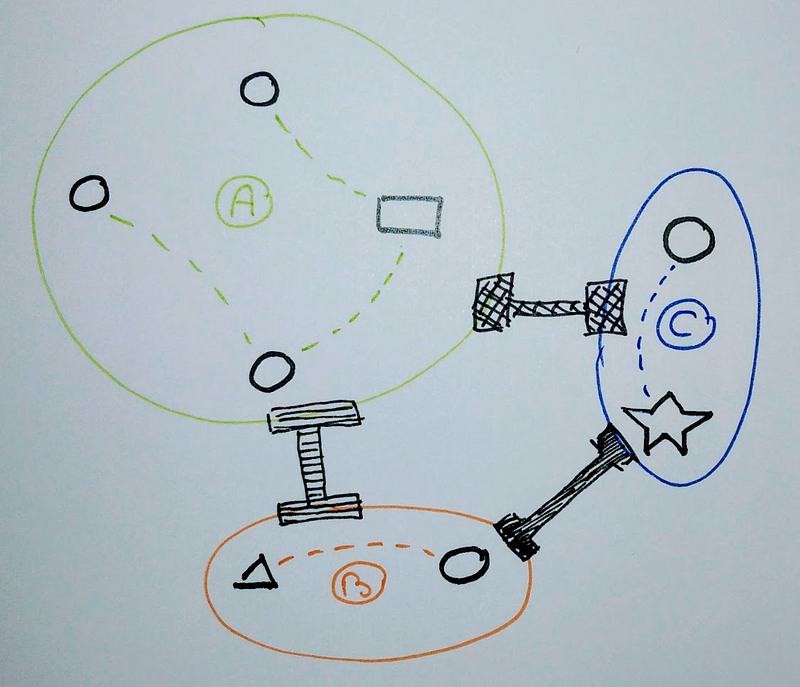
Promises on behavior is shared with protocols using interfaces
Nothing surprising in a digital world actually built upon these principles.
But you can use it on more down to earth systems, to better understand how the parts interact and what are the protocoles. Again, drawing the lines and putting the tags is what will make you discover the studied world, and confronting your lines with others will make you understand it: you will most likely disagree on where are the interfaces and what are the correct protocols.
See, in the following example, what happens if Charlie is in Deborah’s class, contrary to the three others?

Systems, protocol and interfaces don’t need to formally defined to share understanding of the world
Systems are fractal
Systems can be composed of subsystems. Or be part of macro-systems. You adapt the granularity to the problem at hand and zoom as needed.
Our school is its own system in the world, with its own interfaces to other systems like the local administrations, its ministry, parents, etc. You could zoom out to study the town as a system and better understand what the place of the school is, or you can zoom in Alice’s Band inner complicated relationships.
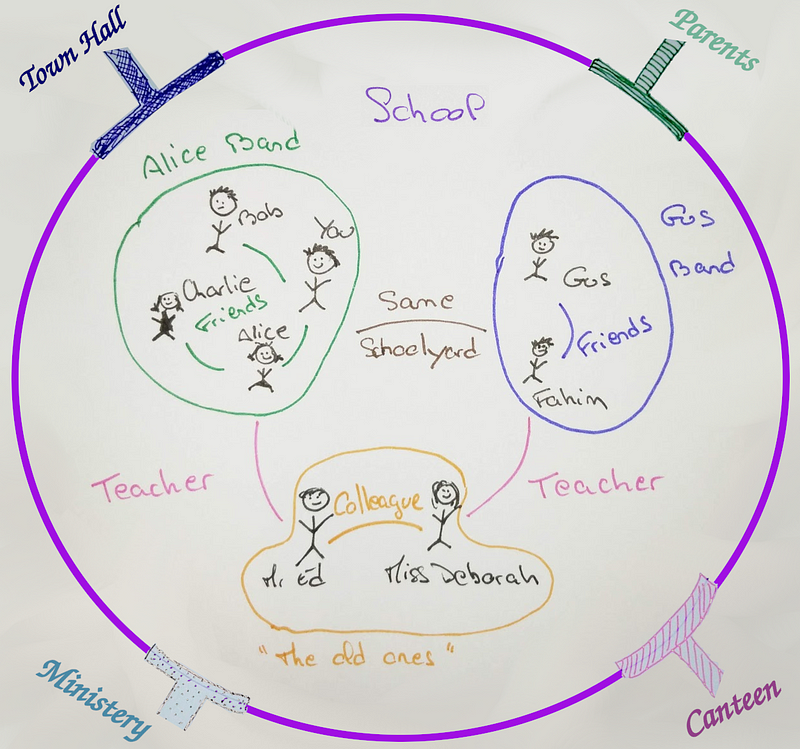
Zoom in and out of system to study different levels of interaction.
Systems are rooted in a world
One last thing: interacting systems are rooted in a world. So you have a virtual horizon to your ecosystem beside which nothing useful happens for that model of the world.
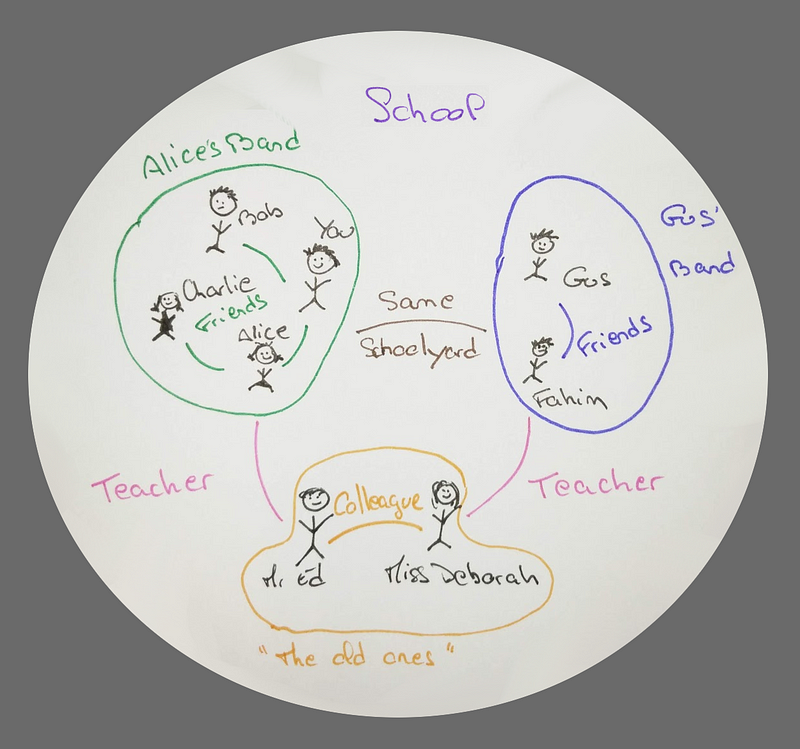
Systems are rooted in a world.
That doesn’t mean it doesn’t exist, just that you don’t want to consider it in your model. And actually, if something from beyond that horizon is important… It’s part of your ecosystem, and you need to understand its interaction. It isn’t a contradiction with the previous fractal part either: when you chose a level, you also choose to exclude what is considered irrelevant for your eco-system at that level. Again, this is part of being a mostly wrong model and not the reallity.
This horizon is extremely useful because it allows defining three modes of interaction for systems:
- [The nominal case, when an interaction went as expected for both parts.]
- [The error mode, when something *expected* went wrong.]
- [The failure mode, when something *unexpected* (i.e. beyond our horizon) happened.]
In our school example, we could have:
- [nominal case: children are in school during break, they play marble and have some fun.]
- [error mode: children are in school during break, they play marble, start a fight and their parents get called.]
- [failure: in the morning, it’s snowing a lot. Children can’t go to school, all adults panic.]
Or perhaps that last case should be an expected error mode? It’s a snowy region, and the city is used to that. There is a special public service that will take care of the children whom parents can’t get a day off —but most can, because remote is expected in that situation.
Well, you see: thinking in systems is useful. Now you know that you decide what the expected errors are, and what is an unexpected failure. It’s the same in your code. You want to know what your world hypothesis are and what events need to be considered to be fatal for your application.
For example, in Java, most people consider the memory management as beeing out of their world. In case of a memory allocation failure (the famous “OutOfMemoryError”), you just have to terminate your application, because you switched to an inconsistant state, out of your understanding of your model. But in some rare cases, it’s totally legit to draw lines around a part of the code and to expect that that part may throw that error (for example when loading a Big Thing in memory), with a recovery scheme (when Thing is Too Big).
In economics, they call the things happening beyond your model horizan externalities{.markup–anchor .markup–p-anchor data-href=“https://en.wikipedia.org/wiki/Externality" rel=“noopener” target="_blank”}. Earth ecosystem is such an externality, and we are just now noticing that perhaps we don’t like the failure mode going with that one, so we are starting to internalise it, i.e. integrate it in our humanity models.
Systems: tentative definition

Where to put the bounds?
So, now that we have a good grasp of what I call interacting system models, let’s try to reach an actionable definition of systems:
1/ Systems are useful, mostly wrong exploration models used to talk about something.
- [Modelling interacting entities with systems is done to help you understand what the contracts between these entities are, what the hard links and the loose connections are, what the expectation of the parts are and how they interact. If it’s not useful and you don’t learn, you missed the point.]
- [Systems don’t need to be right. It’s more interesting to have a simple system definition with clear boundaries allowing sharing ideas that one with thousands of interfaces that nobody can talk about.]
- [Systems are interesting as a visual exploration and communication tool. So share them, discuss them, iterate to make them less wrong.]
2/ Systems are entities.
They have:
- [Bounds. Think about these bounds, and why you want to put them there.]
- [A name, so that you can talk about them. If a system model is well shared, other people should know what you are talking about when you use the chosen name.]
- [Persistence. It lives for some time — sufficiently so that you want to understand it.]
- [An internal language. It’s all the concepts and vocabulary used internally and accepted as an ever-present context to talk efficiently (precisely and succinctly). That language can use internal reference, made-up words, and is generally impenetrable for other systems. When you cross the system bounds, you need to adapt to a common language.]
3/ Systems are interconnected.
- [They make promises about their behaviour, i.e. you can know what to expect from that system when you interact with it, especially what a nominal interaction is and what the error modes are.]
- [They talk to each other through interfaces. Interfaces are access points for other systems. The clearer interfaces are defined and stable upon time, the easier it is to interact with a system.]
- [They use protocols for communication, which is the way they will react to interactions coming through their interfaces. Like for interfaces, the clearer protocols are defined and stable upon time, the easier it is to interact with that system. The protocol use a common language undertood by all interacting systems.]
4/ Systems are fractal.
- [Systems are composed of subsystems, and vice versa.]
- [The granularity is up to you!]
5/ Systems are rooted in a bounded world.
- [Besides that horizon nothing exists.]
- [And if something from the outer world does have consequences on your system, you have only two choices: either that something should be part of your model (see, mostly wrong: iterate!), or it means that your system just switched to an unrecoverable / undefined failure mode: time to reboot it, or panic.]
Thus, systems have 3 modes:
- [Nominal behaviour.]
- [Expected errors (and corresponding reactions).]
- [Failure modes (and undefined states).]
That’s all!
So, next time you are faced with a situation which seems complicated, with lots of moving parts, try to draw boundaries and ask yourself how the parts are connected, what they expect and promise, what are their internal language and if it leaks.
And if you are interested in much more formalized models of the world as systems, you can look at:
- [Simon Wardley maps{.markup–anchor .markup–li-anchor data-href=“https://medium.com/wardleymaps” target="_blank"}, which study evolving systems and what agency you can have on/in them,]
- [Mark Burgess promise theory{.markup–anchor .markup–li-anchor data-href=“http://markburgess.org/TIpromises.html” rel=“noopener” target="_blank"}, and especially “In Search of Certainty{.markup–anchor .markup–li-anchor data-href=“http://markburgess.org/certainty.html” rel=“noopener” target="_blank”}", which is a formalized study of interacting systems at different scales.]
And there is certainly many more! You can look at that wikipedia page I linked{.markup–anchor .markup–p-anchor data-href=“https://en.wikipedia.org/wiki/Systems_theory" rel=“noopener” target="_blank”} at the begining, it’s not that complicated :)
